This series of articles features the 13 unique individuals who have led NASA’s Johnson Space Center (JSC) in Houston during the past 60 years and continue to lead us into the future of human space exploration. The first six installments (Parts 1, 2, 3, 4, 5, and 6) described the Project Management Building and the center’s first 10 directors through 2012. This article, covering the period from 2013 to 2018, focuses on JSC’s 11th director, Ellen Ochoa, whose “JSC 2.0” plan and other initiatives positioned the center to successfully meet the challenges of implementing a diverse human spaceflight program. In addition to making high-level decisions to maintain America’s leadership in human spaceflight, JSC’s center directors’ many varied activities also include greeting astronauts after their return from space, dedicating new facilities, and meeting with local politicians, world leaders, and celebrities. For more information about the directors who led the center, please visit Johnson Space Center Directors | NASA.
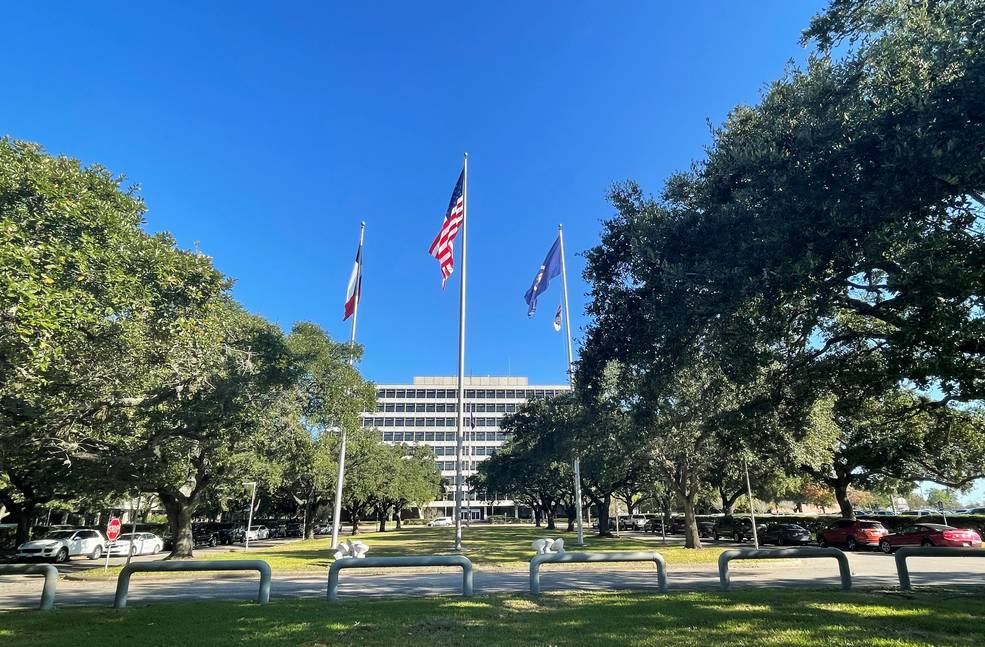
The Project Management Building, known today as Building 1, with its four flagpoles, at NASA’s Johnson Space Center in Houston in November 2021.
Ellen Ochoa (January 2013 to May 2018)
Ochoa joined NASA’s Ames Research Center in California’s Silicon Valley in 1988 as a research engineer and moved to JSC when selected in NASA’s 13th group of astronauts in 1990. She became the first Hispanic woman in space during the STS-56 mission in 1993. She completed three more space shuttle flights, STS-66, STS-96, and STS-110 – the last two visiting the growing International Space Station – logging nearly 1,000 hours in space. In her first management position, she served as deputy director of flight crew operations beginning in December 2002 and as director of flight crew operations from September 2006 until August 2007 when Center Director Coats named her as his deputy. Upon Coats’ retirement, NASA Administrator Charles F. Bolden named Ochoa as JSC’s first Hispanic and second woman center director, effective Jan. 1, 2013.
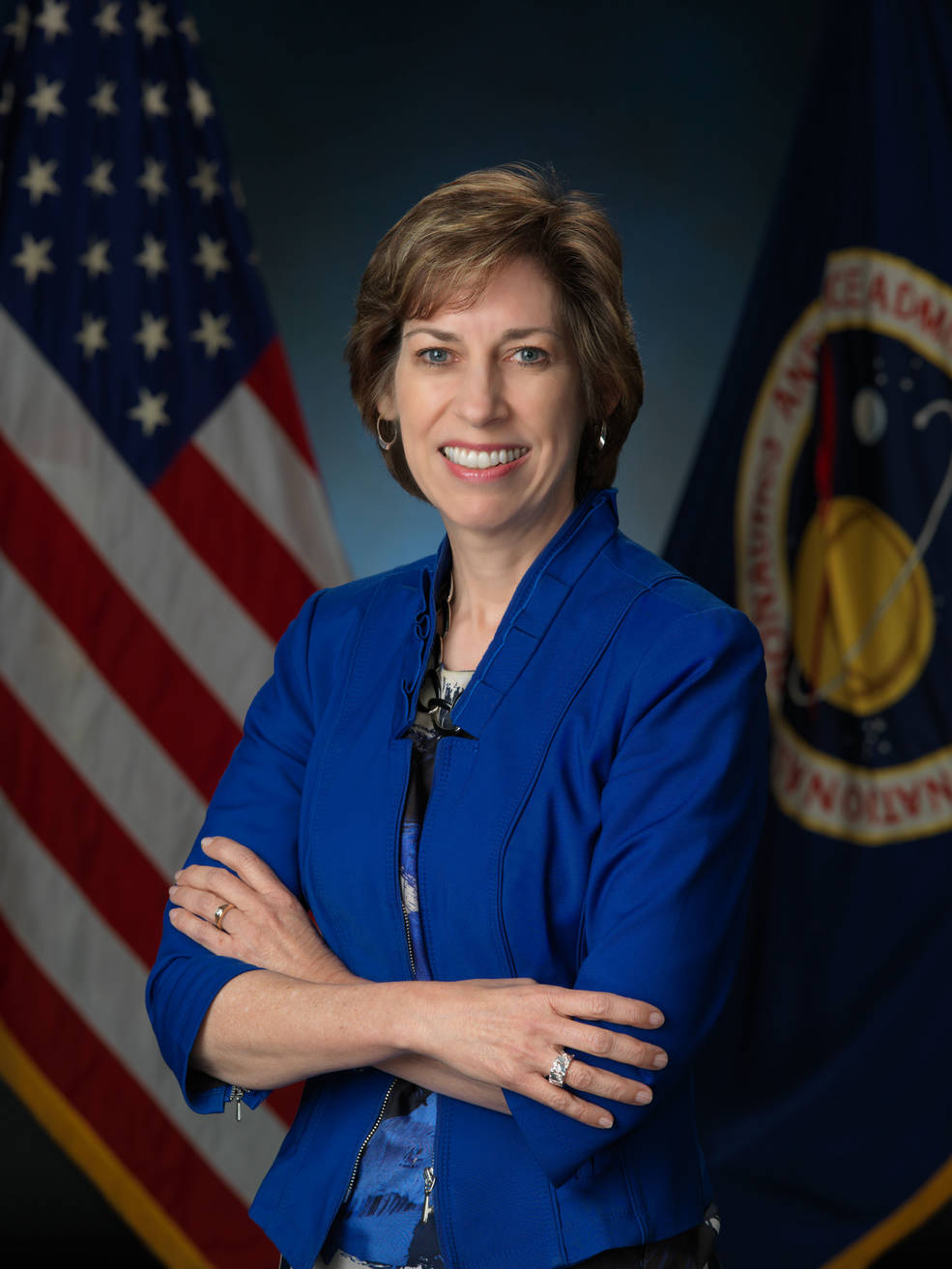
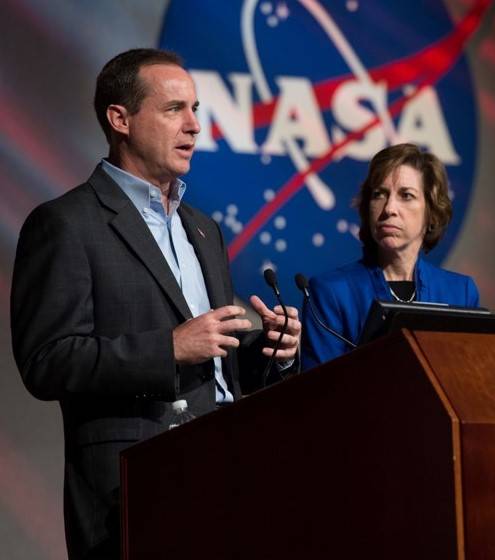
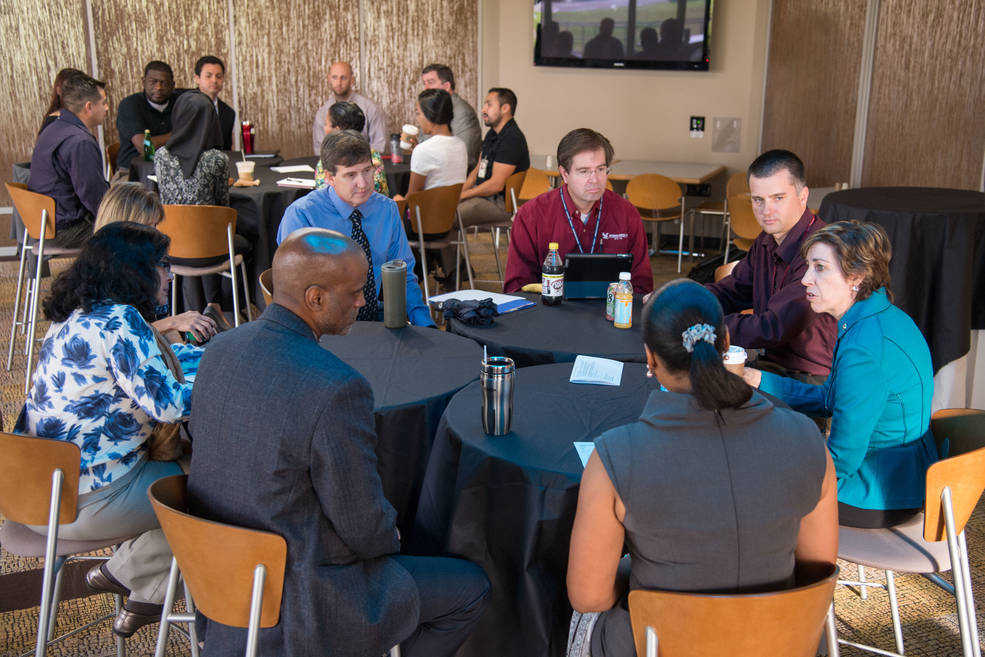
Left: Official portrait of Ellen Ochoa, the 11th director of NASA’s Johnson Space Center (JSC) in Houston. Middle: Ochoa, right, with Deputy Center Director Stephen J. Altemus at an all-hands meeting in JSC’s Teague Auditorium in April 2013. Right: Ochoa, right, during one of the many coffee sessions with employees that she began in 2013.
Ochoa took the helm at JSC at a busy time for the center, and she wanted to position the center to be ready for future activities. Following the retirement of the space shuttle in 2011, the center had responsibility for three major programs to replace the reusable spacecraft’s capabilities. Through NASA’s commercial cargo program, first SpaceX in mid-2012 and Orbital a little more than a year later, began providing cargo services to, and in the case of SpaceX, from the space station. Preparations for the first uncrewed flight of the Orion Multi-Purpose Crew Vehicle (MPCV) were well underway. And with the advent of the Commercial Crew Program, Ochoa realized that JSC would need to modify existing processes to adjust to the new realities of human spaceflight. She instituted the JSC 2.0 initiative to “Advance human exploration by being lean, agile, and adaptive to change.” As part of JSC 2.0, Ochoa first met with division chiefs on a regular basis to elicit suggestions on improvements, then began monthly coffees with employees to seek their input. The JSC 2.0 initiative paid off in a reduction of organizational stovepiping and increased collaboration, and between 2014 and 2017, a 20% reduction in the number of contracts through consolidation and other means. Later iterations, known as JSC 2.016, 2.017, and 2.018, kept the momentum of the original initiative going. Early in her term, Ochoa faced two significant challenges that affected the entire federal government. First, the budget sequestration in March 2013 reduced funding available to the center. The JSC 2.0 initiative partially alleviated some of the sequestration’s effects. The second challenge, the 16-day partial government shutdown in October 2013, put a strain on the center, especially in areas such as real-time operations of the space station.
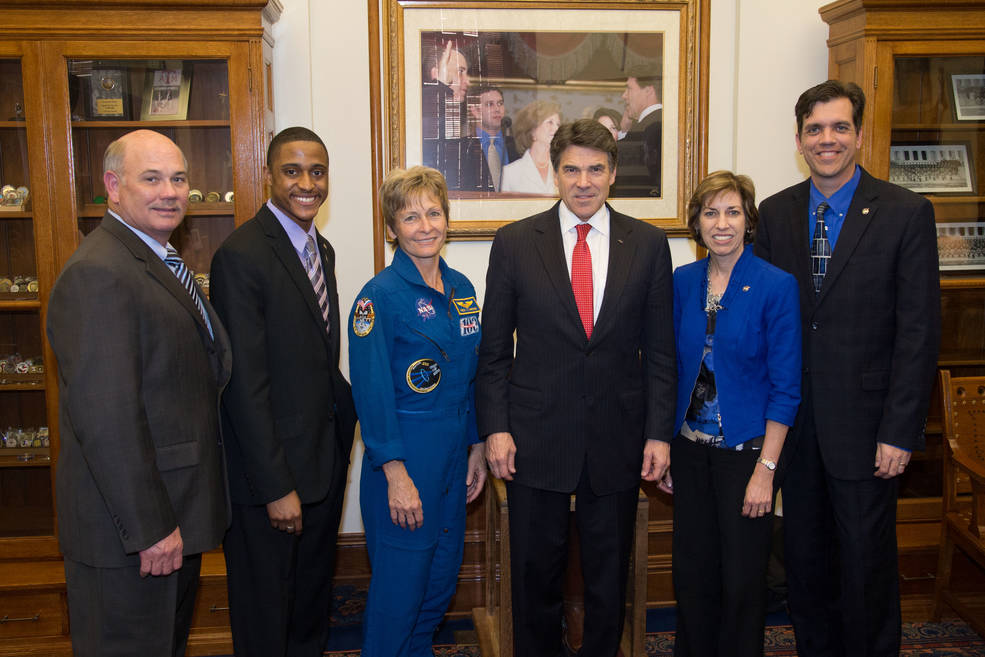
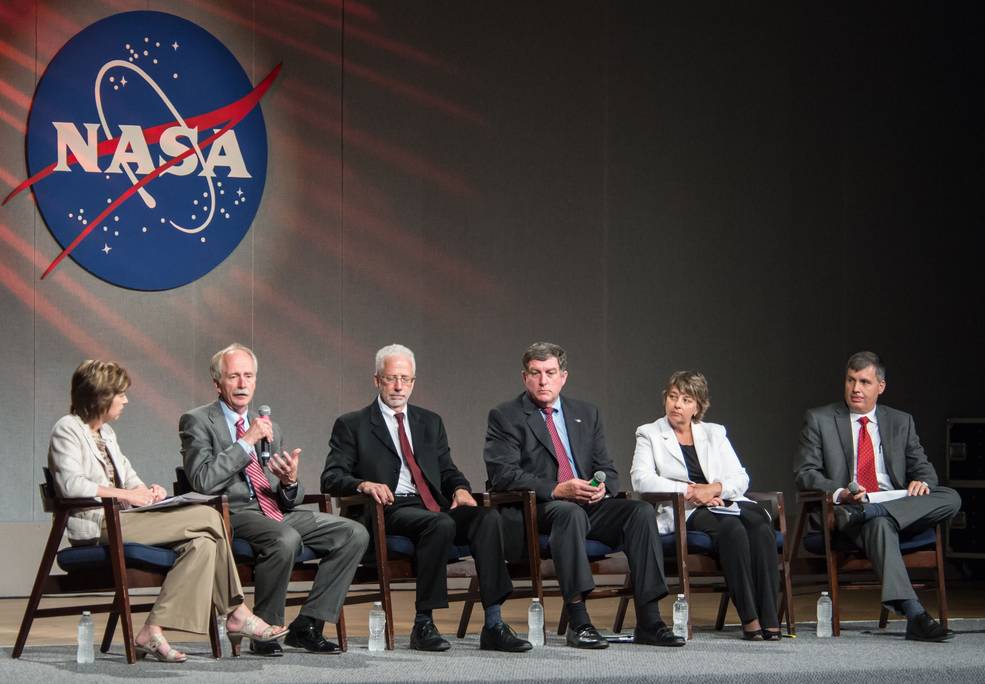
Left: Director of NASA’s Johnson Space Center in Houston Ellen Ochoa, second from right, attending Space Week activities in Austin in March 2013, with Texas Governor Rick Perry, third from right, and NASA astronaut Peggy A. Whitson, third from left. Right: In June 2014, Ochoa, left, chairs a Path to Mars panel discussion with NASA Associate Administrator for Human Exploration and Operations William H. Gerstenmaier, Orion Program Manager Mark S. Geyer, Deputy Center Director Kirk A. Shireman, Director of Engineering Lauri N. Hansen, and Deputy Director of
Engineering J. Stephen “Steve” Stich.
Two weeks after taking office, Ochoa named Director of Engineering Stephen J. Altemus as the deputy center director. She named Lauri N. Hansen to lead engineering, the first woman to do so, with J. Stephen “Steve” Stich as Hansen’s deputy. Altemus left NASA six months later to pursue outside interests, and Ochoa named Kirk A. Shireman, then deputy manager of the International Space Station Program, as the new JSC deputy director. He served in that position for two years, taking the lead on tailoring processes for getting hardware to orbit safely on commercial vehicles. In February 2013, Ochoa selected Kathryn L. “Kathy” Lueders as the deputy manager of the Commercial Crew Program Office, succeeding Brent W. Jett. In November 2015, Lueders became the manager of that office, located at NASA’s Kennedy Space Center in Florida, and Stich became the deputy, located at JSC. After Deputy Center Director Shireman became manager of the International Space Station Program in September 2015 when then-manager Michael T. Suffredini left NASA to join Axiom Space, Ochoa selected Orion Program Manager Mark S. Geyer as the next JSC deputy director. In August 2014, Ochoa merged the Mission Operations and Flight Crew Operations Directorates under a new unified Flight Operations Directorate, led by Brian K. Kelly. She established the Exploration Integration and Science Directorate (EISD), with Stich as its first director, to focus all the various exploration-related activities previously managed by other organizations, including spacewalks and the Astromaterials Research and Exploration Science divisions. In March 2016, Ochoa named Vanessa E. Wyche to succeed Stich as director of EISD.
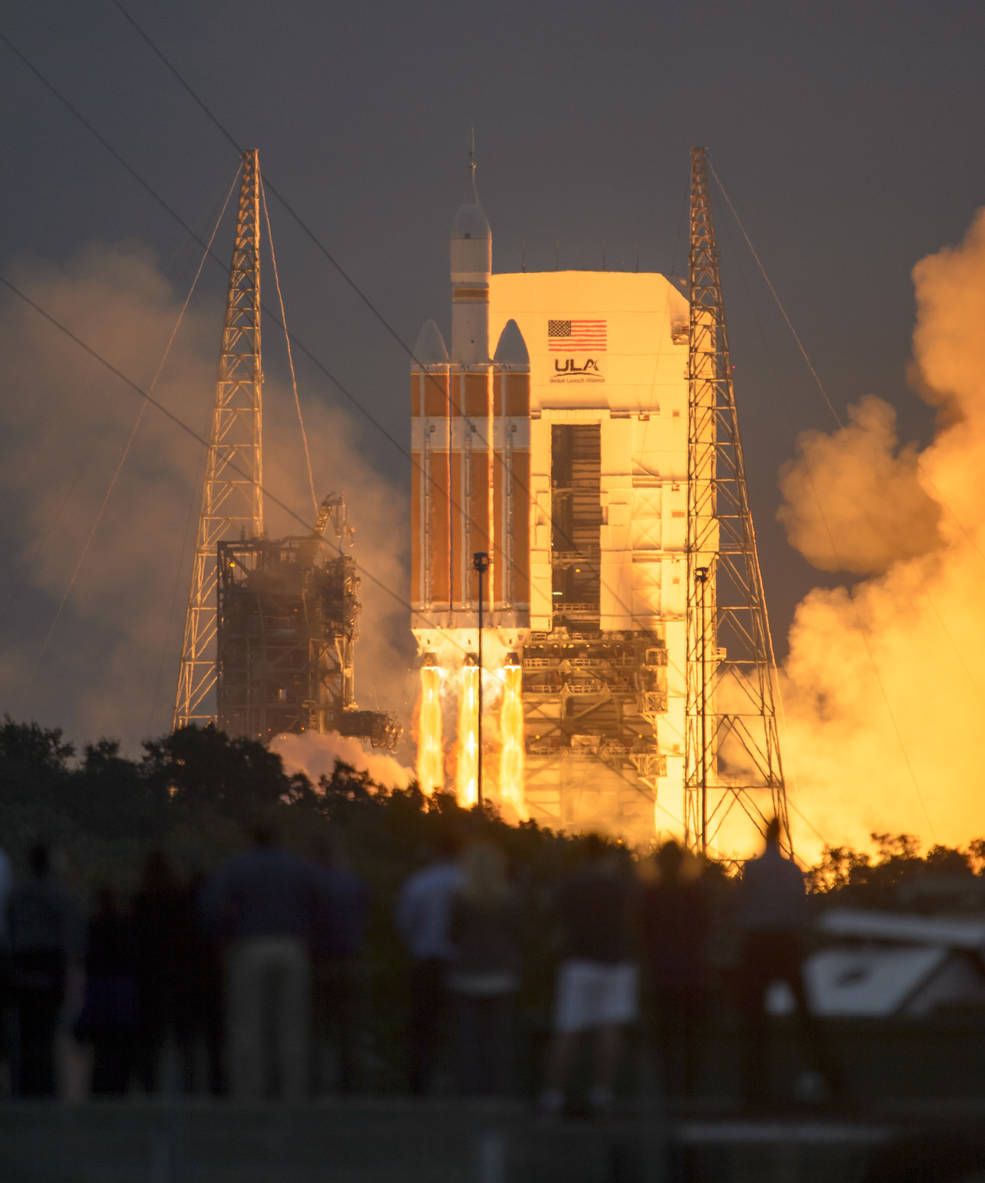
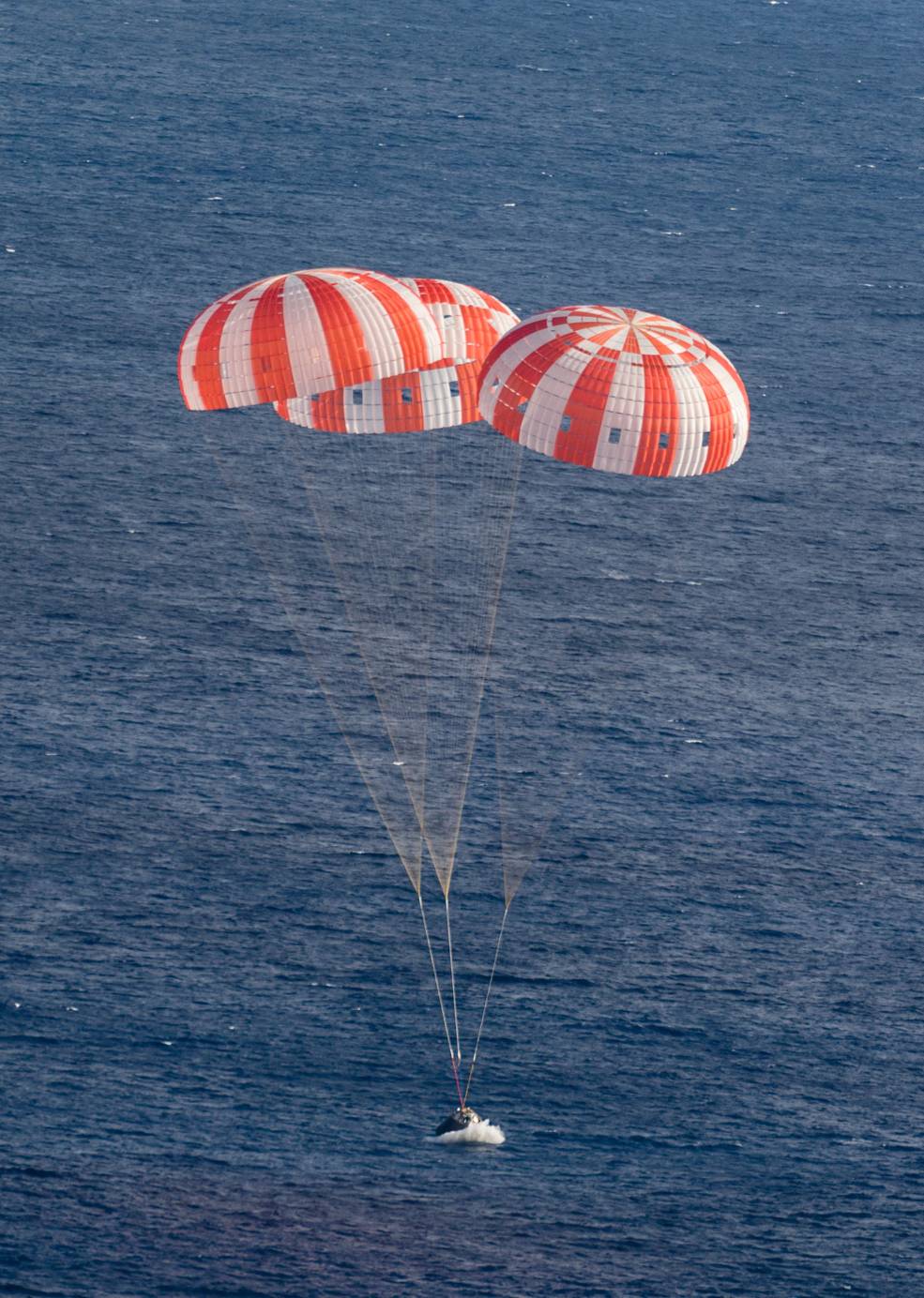
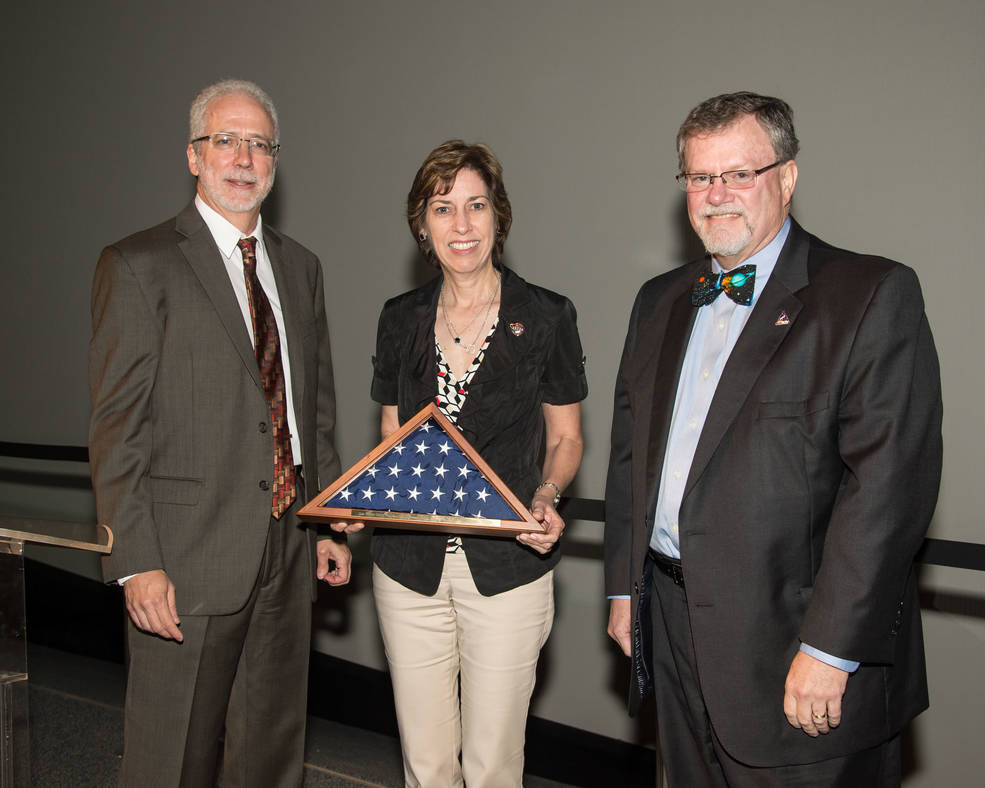
Left: Liftoff of a Delta IV Heavy carrying an Orion capsule on the Exploration Flight Test-1 (EFT-1) mission in December 2014. Middle: Splashdown of the Orion spacecraft at the conclusion of the EFT-1 mission. Right: Ochoa with Orion Program Manager Mark S. Geyer and W. Michael Hawes of Lockheed Martin at the Orion EFT-1 awards ceremony in May 2015, with a flag flown aboard the mission.
America’s newest human-rated spacecraft made its first foray into space on Dec. 5, 2014. Under contract to NASA, Lockheed Martin builds the Orion MPCV as the vehicle to take American astronauts back to the Moon and eventually beyond. Orion’s first mission, called Engineering Flight Test-1 (EFT-1), used a Delta-IV Heavy booster, at the time the most powerful operational rocket. The 4.5-hour mission demonstrated Orion’s space-worthiness, tested the spacecraft’s heat shield during reentry into the Earth’s atmosphere, and proved the capsule’s recovery systems. Although the EFT-1 mission did not include a crew, the Orion capsule flew higher and faster than any human-rated spacecraft in more than 40 years. The test flight carried a live Crew Module and a mockup Service Module that remained attached to the rocket’s upper stage.
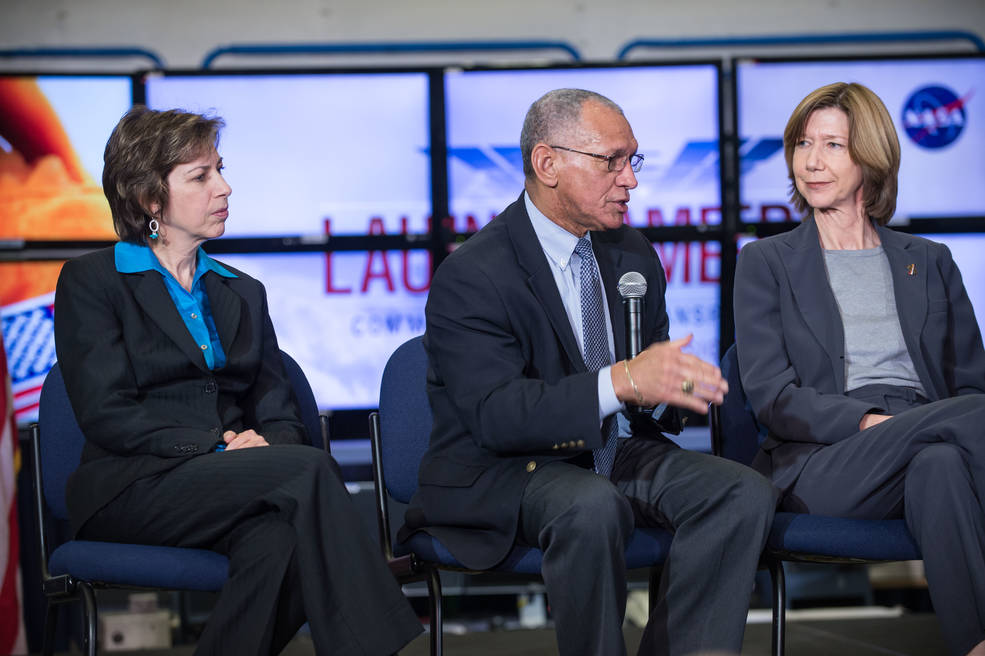
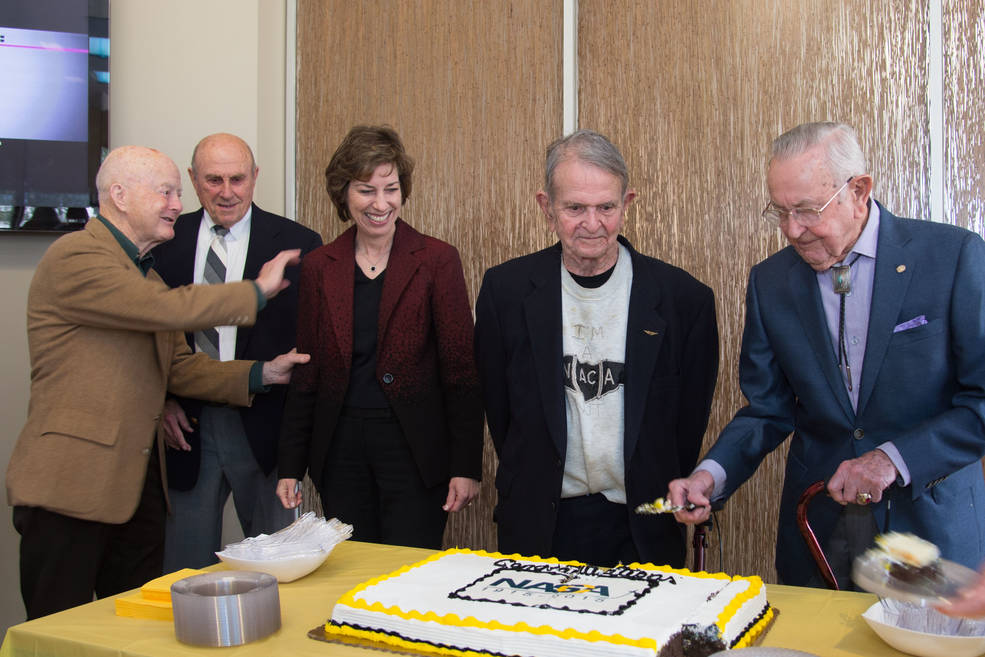
Left: Director of NASA’s Johnson Space Center in Houston Ellen Ochoa, left, with NASA Administrator Charles F. Bolden and Commercial Crew Program Manager Kathryn L. “Kathy” Lueders during a January 2015 media event. Right: In March 2015, Ochoa helps to celebrate the 100th anniversary of the founding of the National Advisory Committee for Aeronautics (NACA), NASA’s precursor organization, with Christopher C. Kraft, a former NACA employee, and JSC’s second director (1972-1982).
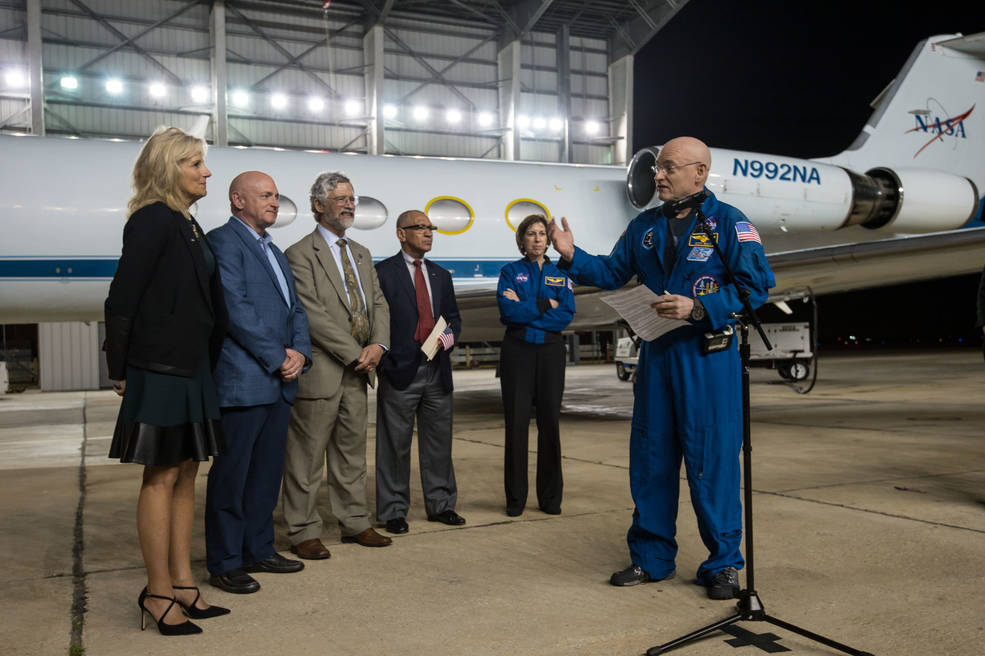
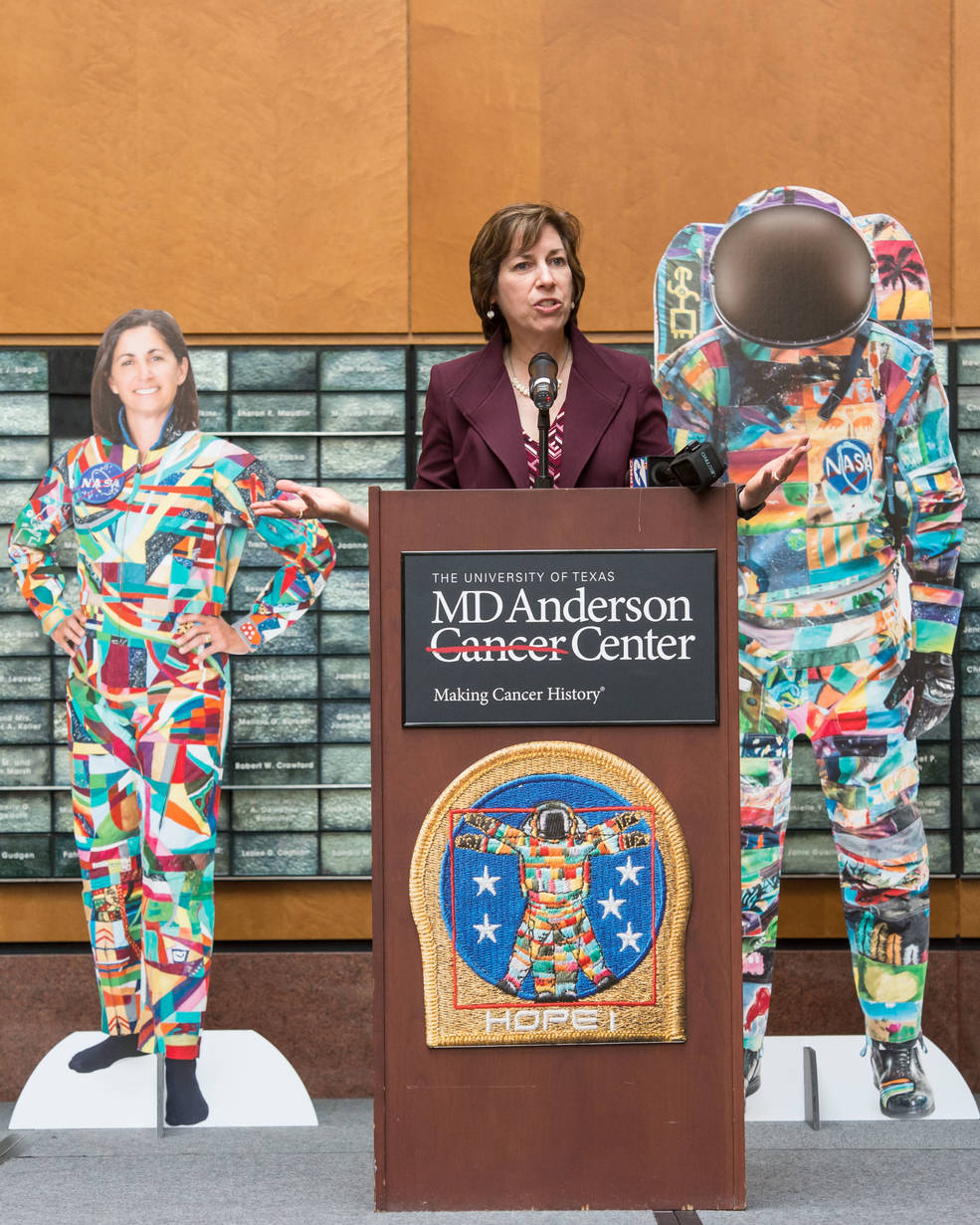
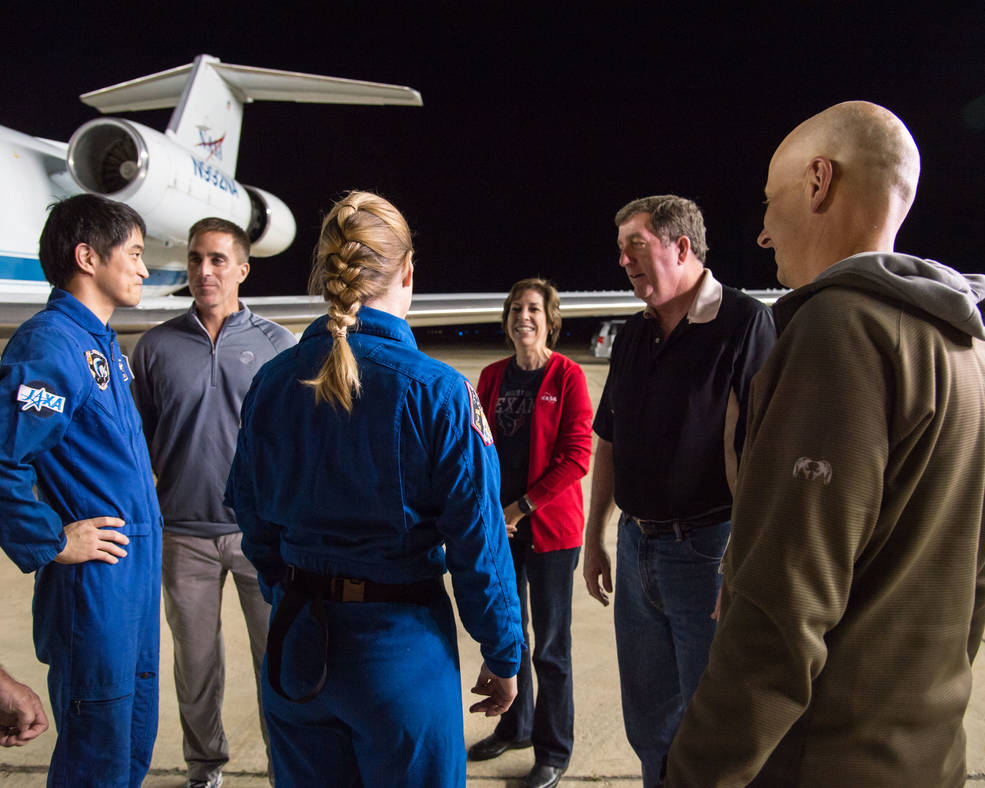
Left: In March 2016, at Ellington Field to welcome home NASA astronaut Scott J. Kelly, right, after his one-year mission aboard the International Space Station, are Second Lady Jill Biden, left, former NASA astronaut Mark E. Kelly, director of the White House Office of Science and Technology John P. Holdren, NASA Administrator Charles F. Bolden, and director of NASA’s Johnson Space Center in Houston Ellen Ochoa. Middle: At The University of Texas MD Anderson Cancer Center in July 2016, Ochoa speaks at a ceremony to announce NASA’s participation in the Hope 1: Spacesuit Project. Right: In October 2016, Ochoa, center, welcomes Expedition 42 astronauts Kathleen H. Rubins of NASA and Takuya Onishi of the Japan Aerospace Exploration Agency to Ellington Field.
During Ochoa’s time as JSC director, international crews completed 22 long-duration expeditions aboard the space station, including NASA astronaut Scott J. Kelly’s one-year mission and the concurrent Twins Study with his brother, retired astronaut Mark E. Kelly. Commercial cargo resupply missions began with SpaceX’s Dragon vehicles in 2012, joined one year later by Orbital Sciences Corporation’s Cygnus spacecraft. Following the space shuttle’s retirement, crew rotations to the space station took place on Russian Soyuz vehicles. Under development in the 2010s, SpaceX’s Crew Dragon and the Boeing Corporation’s CST-100 Starliner spacecraft aimed to resume astronaut launches from U.S. soil, with their respective first test flights in March and December 2019, respectively.
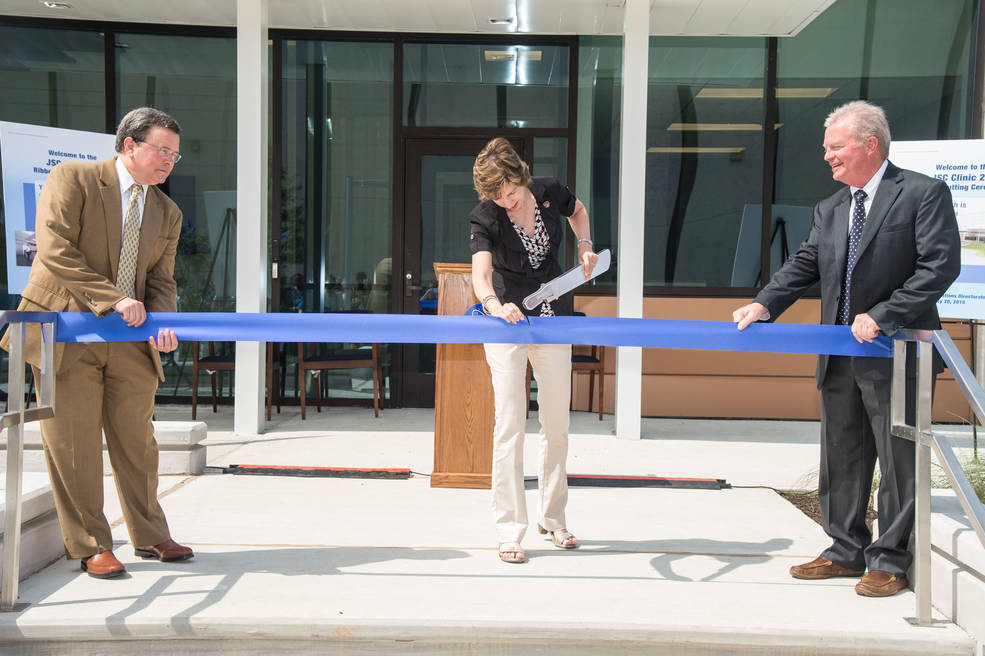
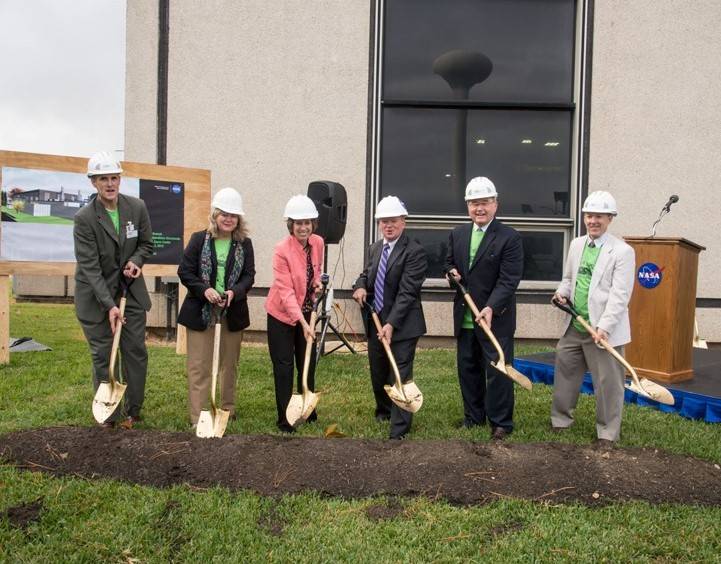
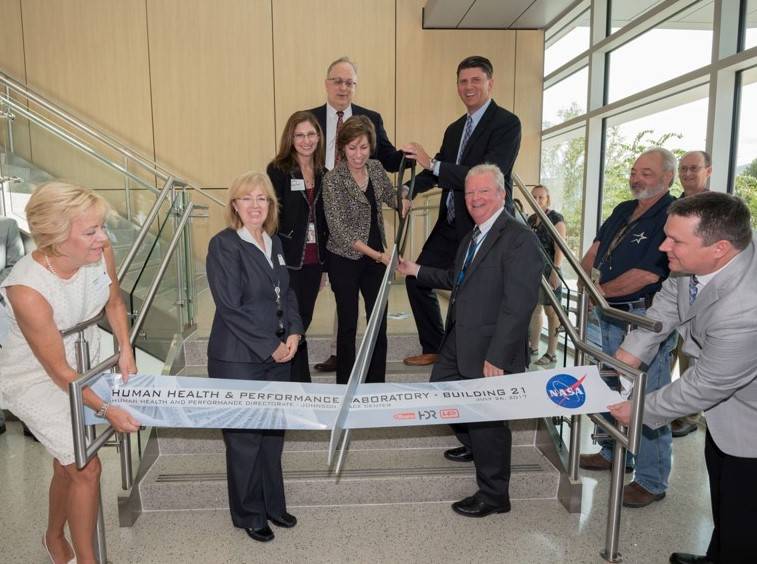
Left: In May 2015, Director of NASA’s Johnson Space Center (JSC) in Houston Ellen Ochoa, center, cuts the ribbon with an oversized scalpel for the new JSC Clinic in Building 45, as director of Human Health and Performance Dr. Jeffrey R. Davis, left, and Center Operations Director Joel B. Walker hold the ribbon. Middle: In October 2015, Ochoa, third from left, participates in the groundbreaking for the Building 24 Combined Heat and Power project. Right: Ochoa, center, cutting the ribbon at the opening of Building 21, the Human Health and Performance Laboratory, in July 2017.
Several major construction projects took place during Ochoa’s time as center director. In May 2015, she officiated at the ribbon-cutting ceremony, with a ceremonial oversized scalpel, of the new JSC Clinic in the wing of Building 45 that formerly housed the library. In August 2015, she participated in the groundbreaking for Building 21, the Human Health and Performance Laboratory. The labs, previously located in Building 37, had outgrown that 1960s-era building and needed a state-of-the-art facility. Ochoa led the ribbon-cutting ceremony at the opening of Building 21 in July 2017. Ochoa participated in the ground-breaking ceremony for Center Operations Directorate’s Combined Heat and Power project in Building 24. The facility, developed through a partnership with the Department of Energy’s Federal Energy Management Program, opened in May 2018 to provide 70%of the center’s electricity requirements.
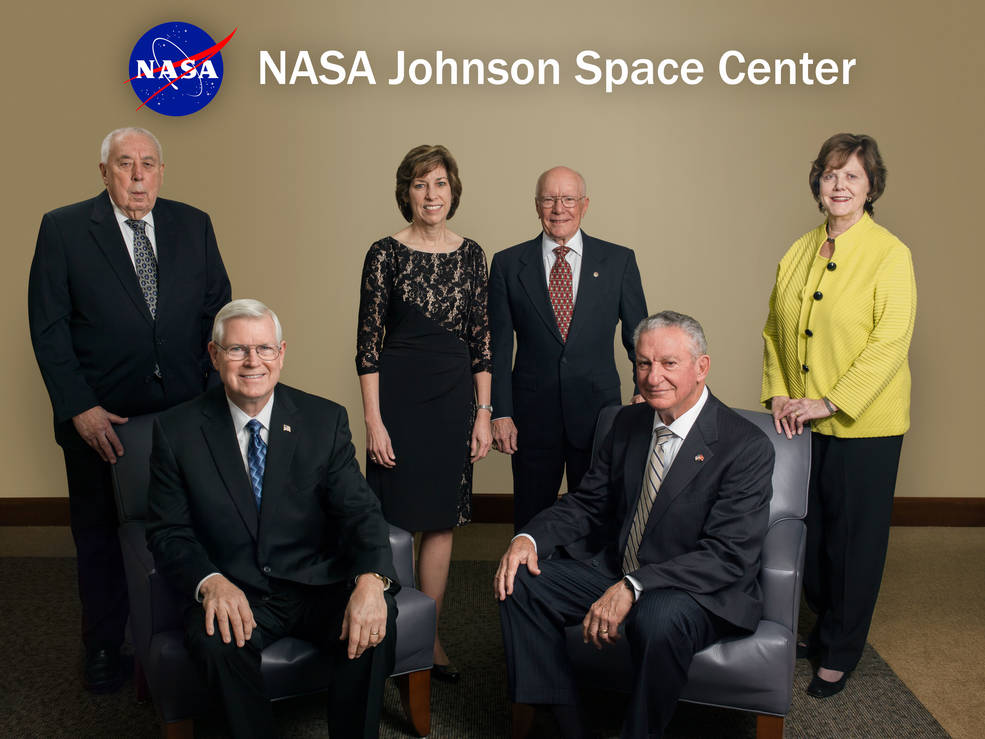
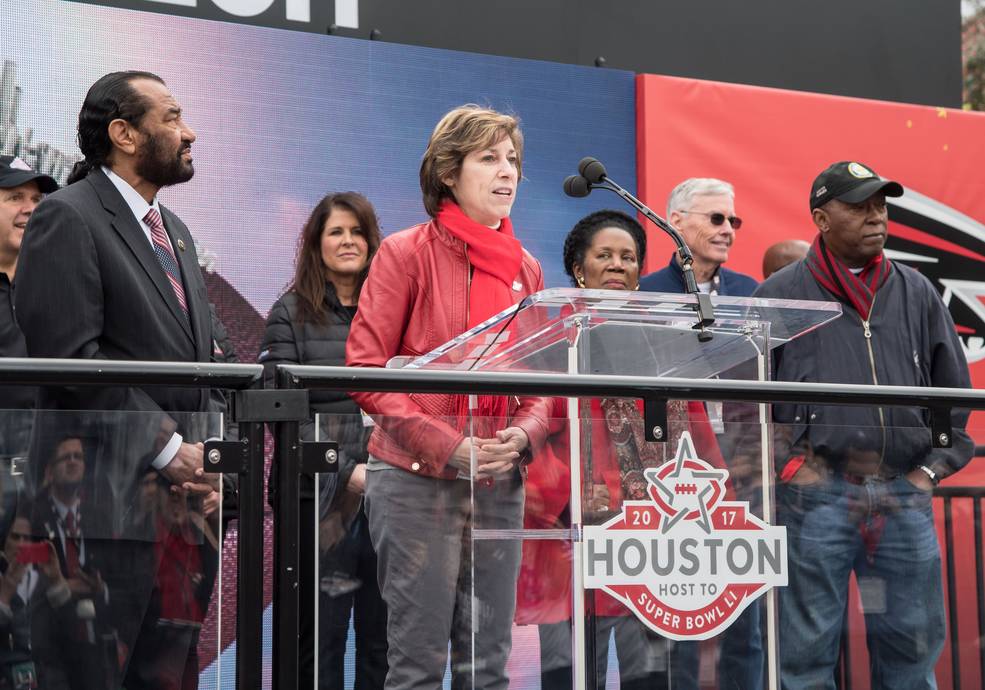
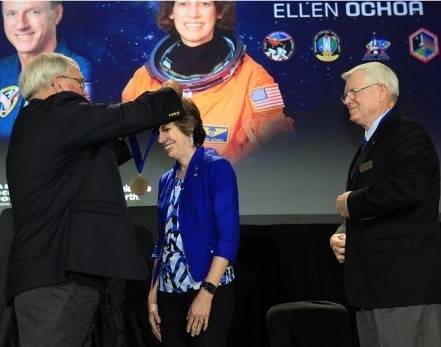
Left: In January 2017, director of NASA’s Johnson Space Center (JSC) in Houston Ellen Ochoa hosted a reunion of former center directors – George W.S. Abbey, left, Michael L. Coats, Ochoa, Gerald D. Griffin, Jefferson D. “Beak” Howell, and Carolyn L. Huntoon. Middle: In January 2017, Ochoa speaking at the grand opening of the NFL Live event for Super Bowl LI in downtown Houston, with Mayor Sylvester Turner, right, and other Houston area politicians. Right: In May 2017, former astronaut Daniel C. Brandenstein bestows a medal on Ochoa during her induction into the U.S. Astronaut Hall of Fame as inductee and former JSC Director Michael L. Coats looks on.
As the premier center for human spaceflight, JSC has historically enjoyed a positive relationship with the city of Houston, the state of Texas, and their respective politicians, regardless of party affiliation. Directors at JSC have engaged the center in community activities, such as the annual Space Week activities in Austin and various parades throughout the year. The center has supported numerous collaborations with local universities and medical institutions. When Super Bowl LI came to Houston in 2017, the JSC team participated on the host committee. Houston Mayor Sylvester Turner and several local U.S. Representatives joined Ochoa for the opening of the space-themed NFL Live Event at Discovery Green. In recognition of her career accomplishments, the U.S. Astronaut Hall of Fame inducted Ochoa. On May 19, 2017, in the space shuttle Atlantis facility at the Kennedy Space Center Visitor Complex in Florida, former astronaut Daniel C. Brandenstein presented Ochoa with her medal.
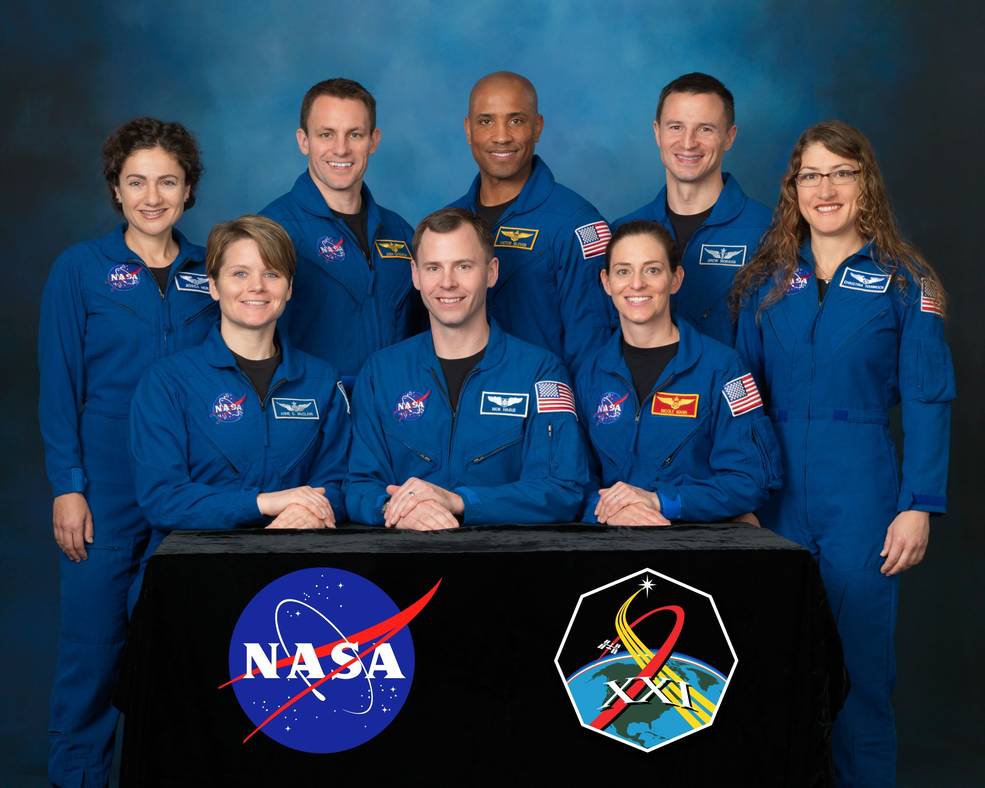
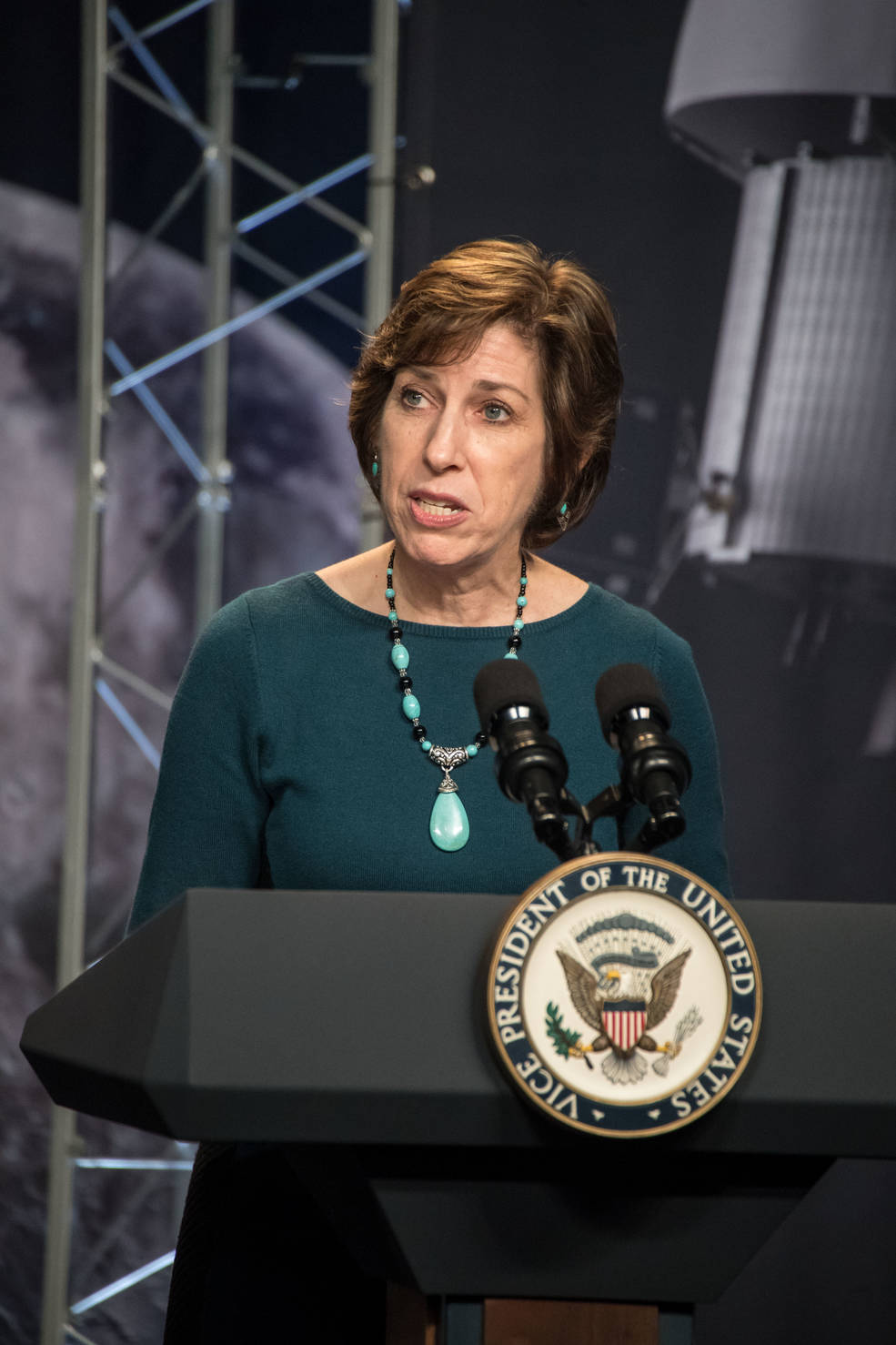
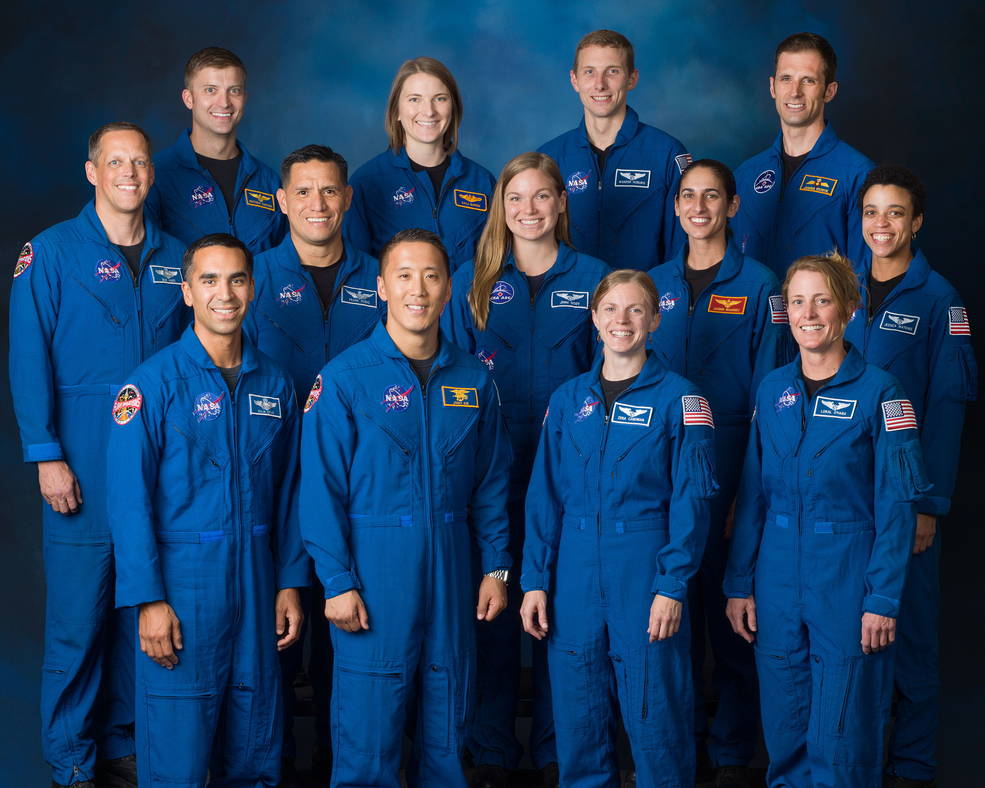
Left: The eight members of the astronaut class of 2013. Middle: Director of NASA’s Johnson Space Center in Houston Ellen Ochoa speaks at the June 2017 announcement of the astronaut class of 2017. Right: The 12 members of the astronaut class of 2017.
During Ochoa’s tenure as JSC director, NASA selected two new astronaut classes, chosen for flights to the space station and for future exploration missions. The eight-member Class of 2013, who named themselves the “Eight Balls,” consisted of four women and four men, the first astronaut class with an equal gender mix. The 12-member Class of 2017, nicknamed “The Turtles,” comprised seven men and five women. Two astronauts from the Canadian Space Agency joined the group for training.
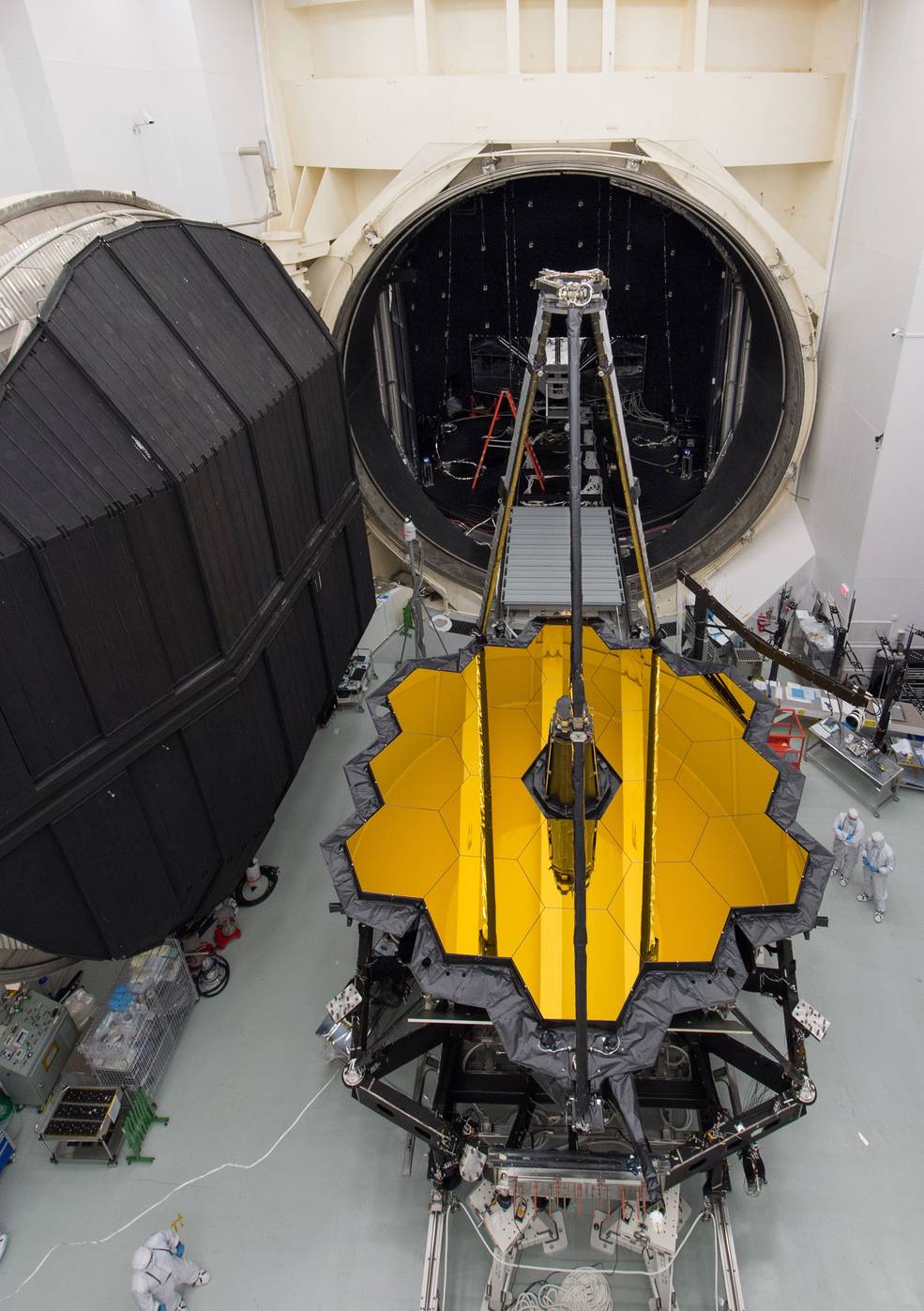
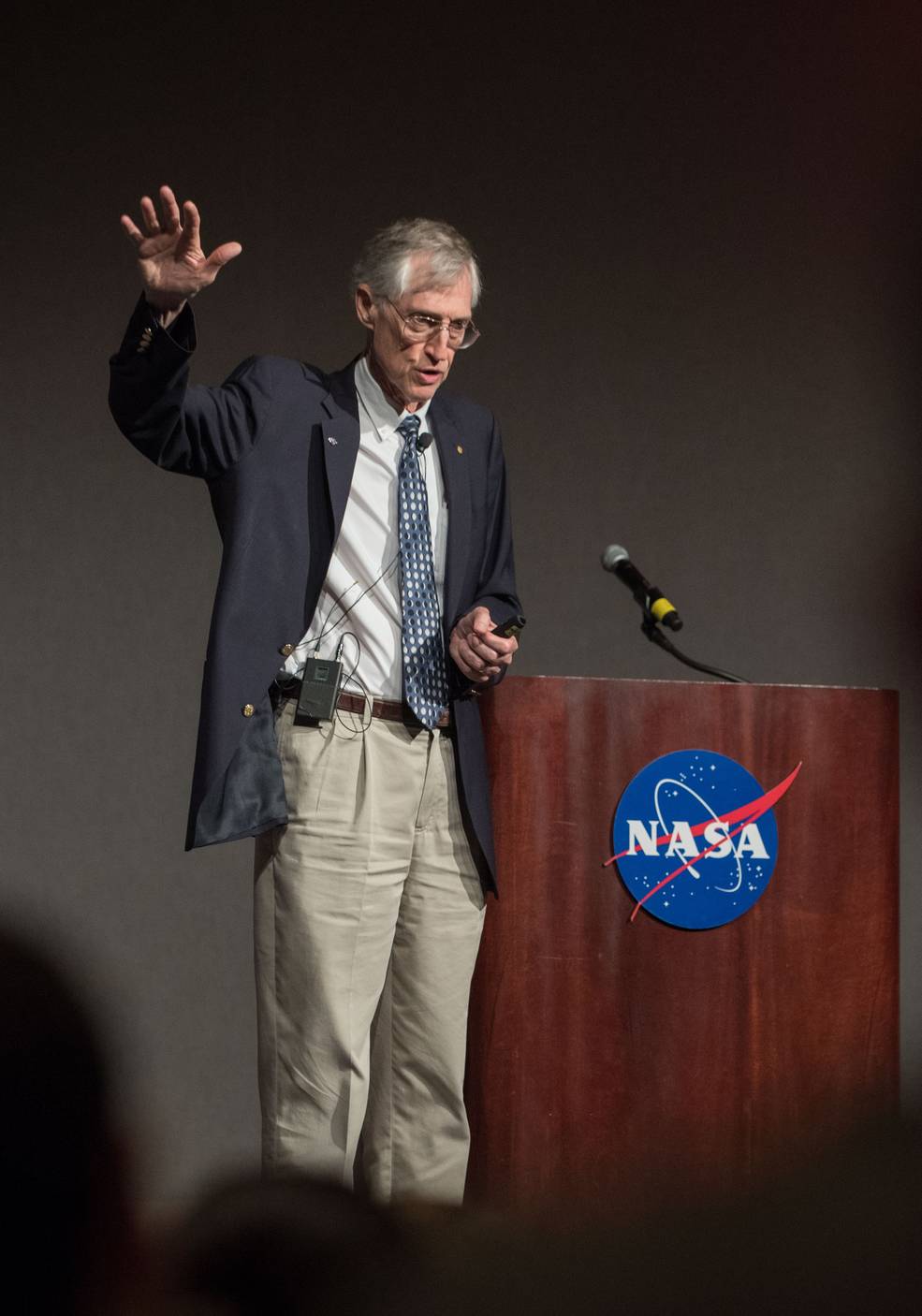
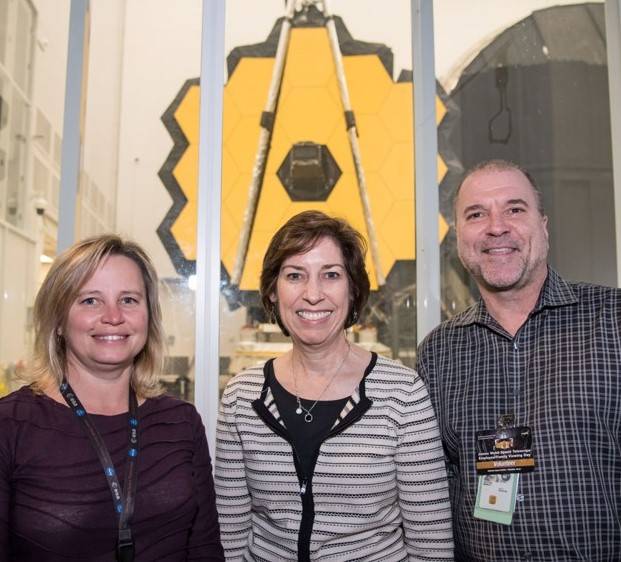
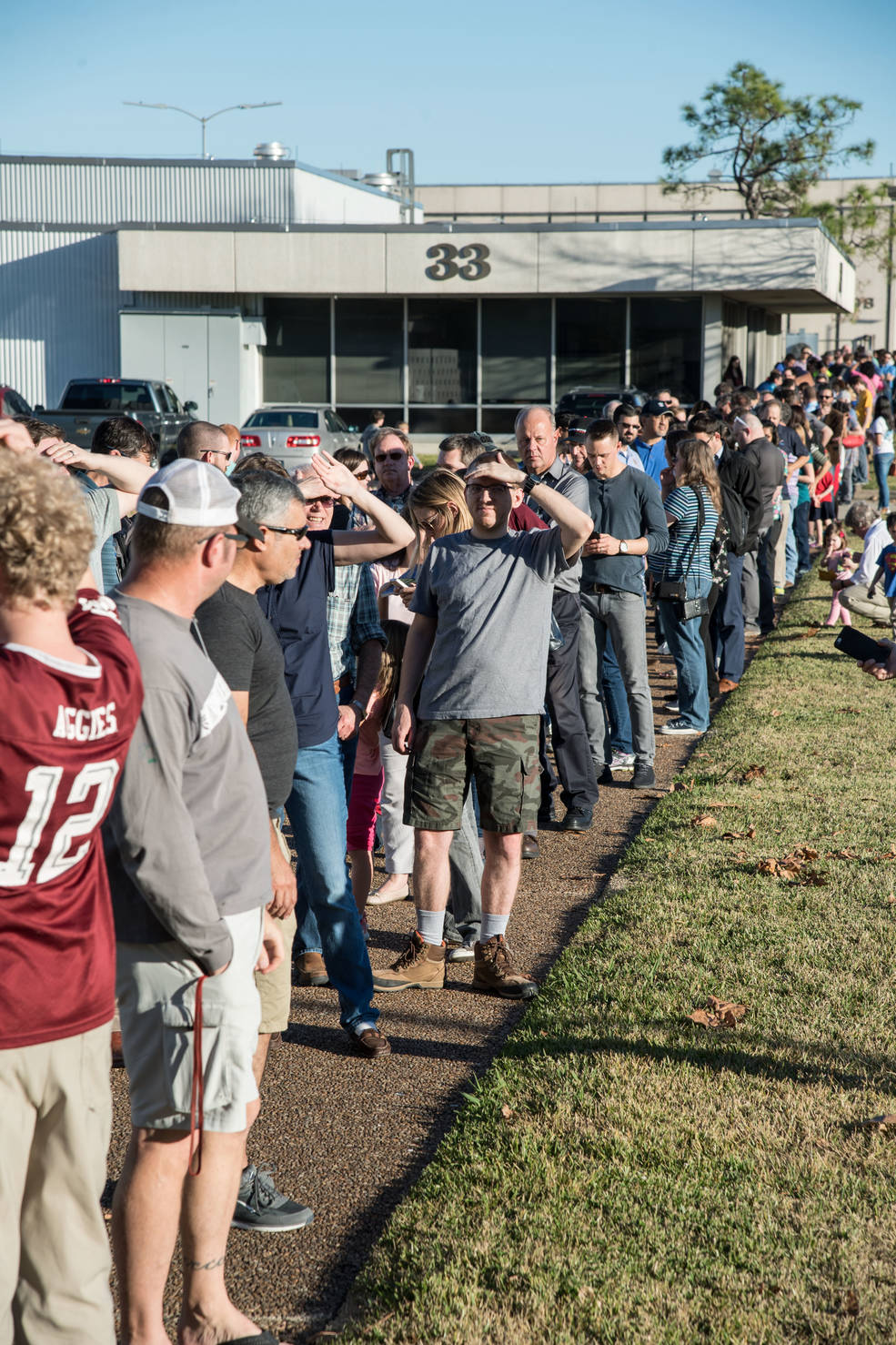
Left: The James Webb Space Telescope (JWST) outside Chamber A in the Space Environment Simulation Laboratory in Building 32 of NASA’s Johnson Space Center (JSC) in Houston. Middle left: Nobel laureate John Mather, JWST chief scientist, gives a talk to JSC employees in the Teague Auditorium. Middle right: JSC Director Ellen Ochoa (middle) during the employee viewing of the JWST. Right: Some employees stood in line for up to four hours for a chance to view the telescope.
In 2017, JSC played host to a very special visitor – the James Webb Space Telescope (JWST). On May 7, it arrived from NASA’s Goddard Space Flight Center in Greenbelt, Maryland. Workers in the Building 32 Space Environment Simulation Laboratory placed the large telescope into Chamber A, built in the 1960s to test Apollo spacecraft, to conduct the final thermo-vacuum tests to ensure its instruments could survive the harsh condition of space at its operational location one million miles from Earth. After completion of the tests, the JWST emerged from the chamber on Dec. 1 and JSC arranged for employees and their families to see the telescope. The event generated so much interest that some stood in line for up to four hours for a chance to see the instrument. Following its Christmas Day 2021 launch, JWST has reached its operational location orbit around the L2 Lagrange Point and has begun its mission to reveal the secrets of the universe.

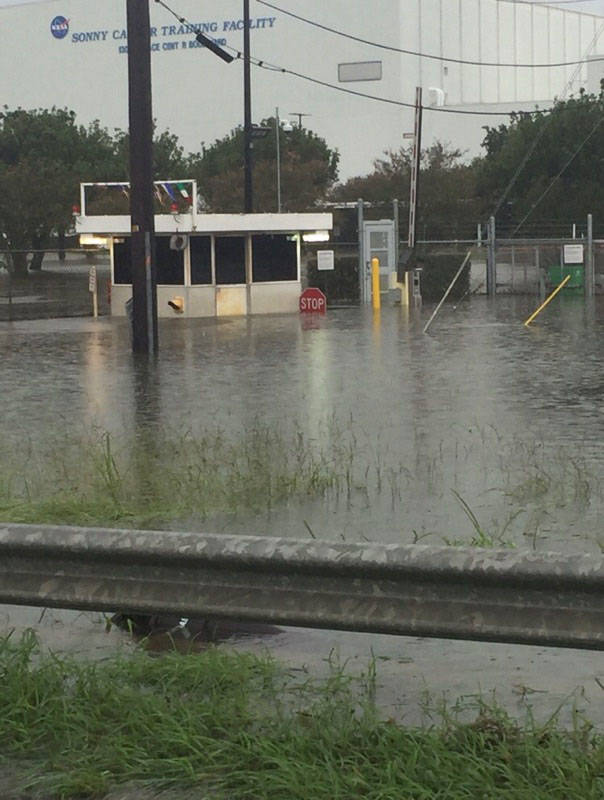
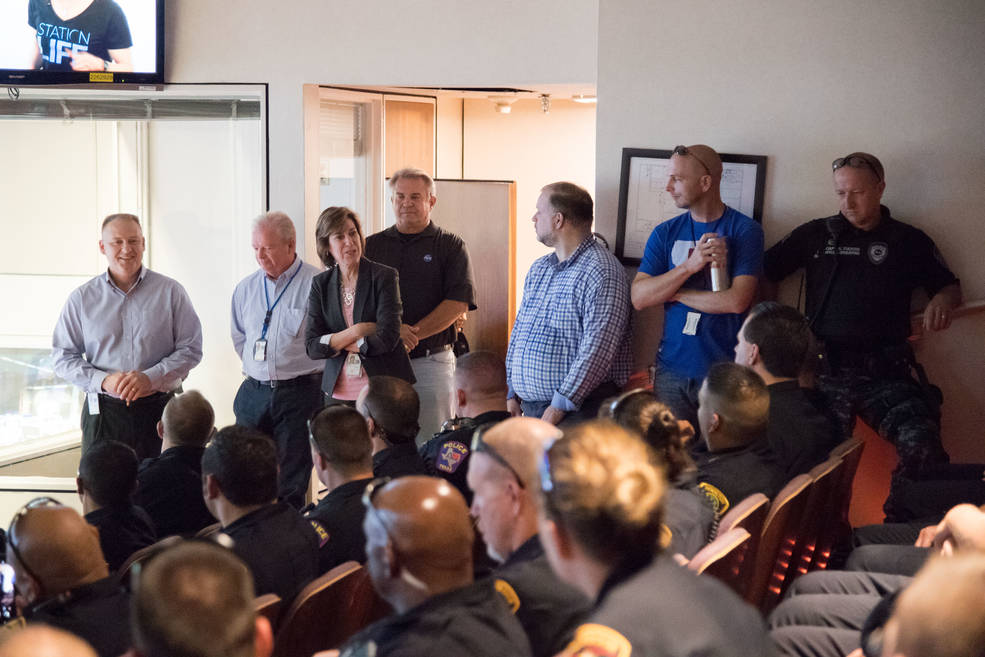
Left: In August 2017, Hurricane Harvey makes landfall on the Texas coast, photographed by the Expedition 52 crew aboard the International Space Station. Middle: The guard shack at the Sonny Carter Training Facility under several feet of water in the aftermath of Hurricane Harvey. Right: Director of NASA’s Johnson Space Center in Houston Ellen Ochoa addresses first responders who provided vital assistance in the aftermath of Hurricane Harvey during their tour of the center.
The arrival of Hurricane Harvey to southeast Texas in August 2017 brought extensive flooding to the region including the area around JSC. Primary concerns for the center included keeping the workforce safe, even as many dealt with flooded homes, and continuing operations such as the space station and testing of the JWST. Coordination with the European Space Agency assured the return of two space station astronauts from their landing in Kazakhstan following disruptions of aircraft operations at Ellington Field. The center provided much-needed support to employees dealing with long-term housing and other issues. Ochoa provided a tour of JSC facilities to first responders from the area to thank them for all their work in ensuring employees’ safety.
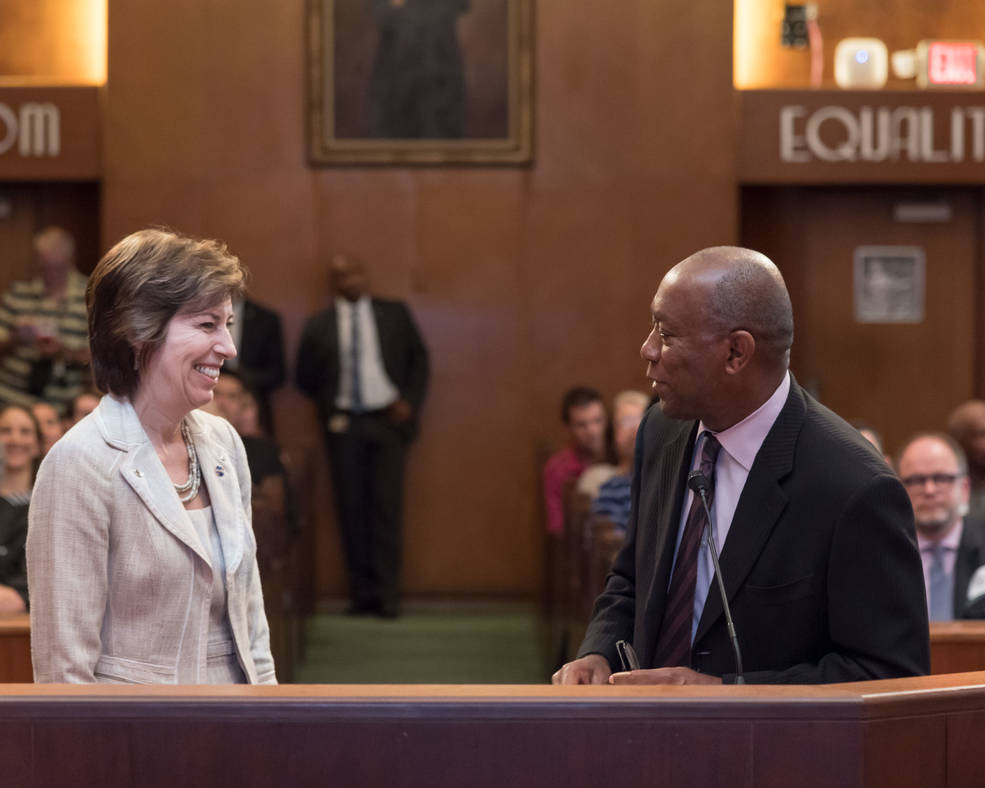
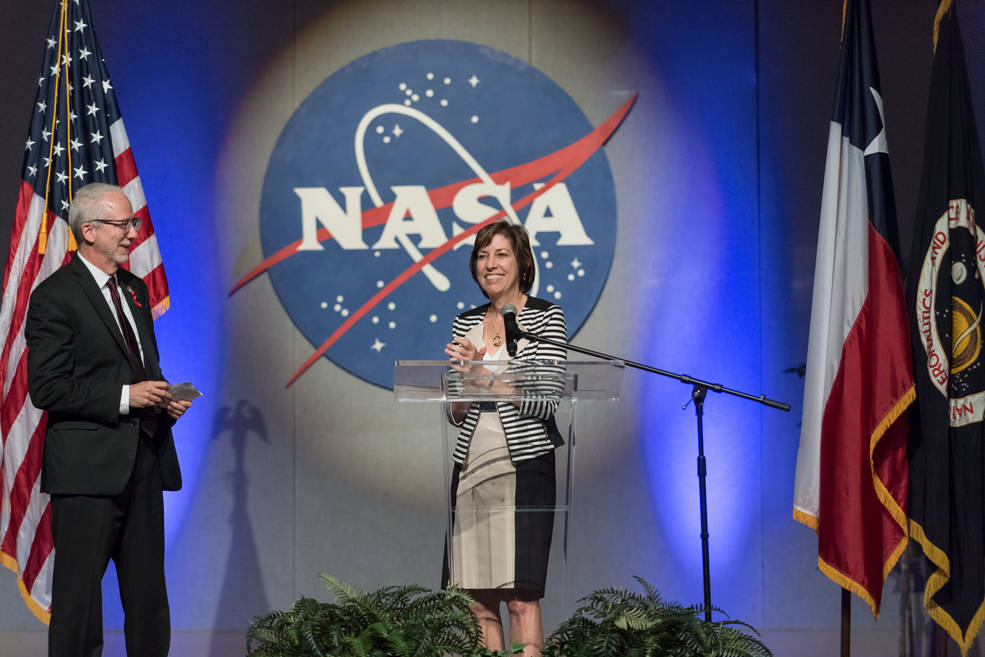
Left: Director of NASA’s Johnson Space Center (JSC) in Houston Ellen Ochoa, left, smiles as Houston Mayor Sylvester Turner declares May 15, 2018, as Ellen Ochoa Day. Right: During an all hands meeting in May 2018, Ochoa announces the selection of Mark S. Geyer as her successor as JSC Director.
NASA Administrator James F. “Jim” Bridenstine announced on May 14, 2018, the selection of former JSC Deputy Director Geyer as the center’s next director. After serving as JSC deputy director beginning in September 2015, Geyer left JSC in October 2017 to serve as acting deputy associate administrator technical for the Human Exploration and Operations Mission Directorate at NASA Headquarters in Washington, D.C. During his time at Headquarters, Vanessa E. Wyche and Melanie W. Saunders successively served as acting deputy center director. Geyer assumed the director’s position on May 25, 2018, when Ochoa retired after 30 years with the agency.
The next installment in this series will cover JSC’s next two directors, taking us up to the present day as we continue to conduct research aboard the space station and prepare to resume exploration missions.
John Uri
NASA Johnson Space Center





























